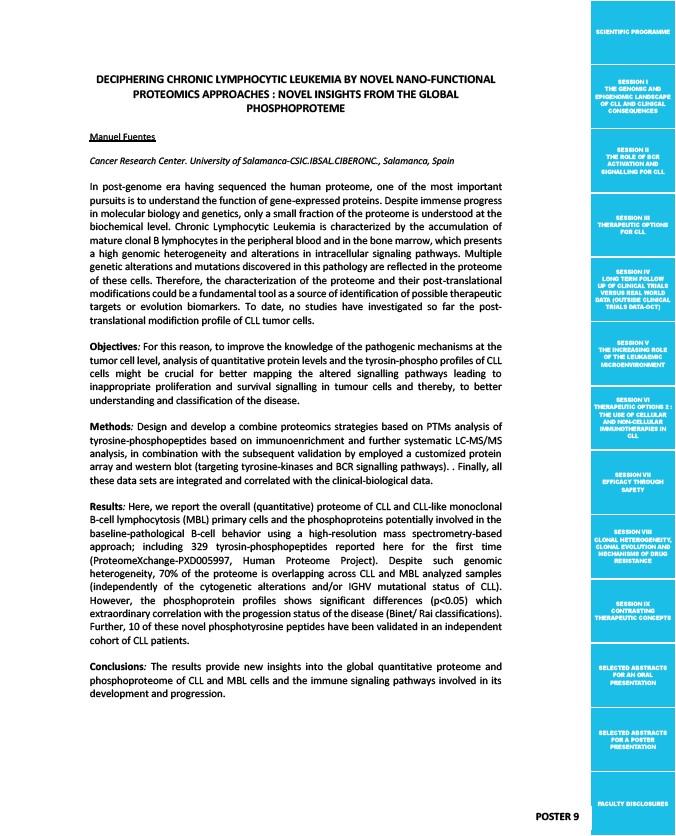
SCIENTIFIC PROGRAMME
SESSION I
THE GENOMIC AND
EPIGENOMIC LANDSCAPE
OF CLL AND CLINICAL
CONSEQUENCES
SESSION II
THE ROLE OF BCR
ACTIVATION AND
SIGNALLING FOR CLL
SESSION III
THERAPEUTIC OPTIONS
FOR CLL
SESSION IV
LONG TERM FOLLOW
UP OF CLINICAL TRIALS
VERSUS REAL WORLD
DATA (OUTSIDE CLINICAL
TRIALS DATA-OCT)
SESSION V
THE INCREASING ROLE
OF THE LEUKAEMIC
MICROENVIRONMENT
SESSION VI
THERAPEUTIC OPTIONS 2 :
THE USE OF CELLULAR
AND NON-CELLULAR
IMMUNOTHERAPIES IN
CLL
SESSION VII
EFFICACY THROUGH
SAFETY
SESSION VIII
CLONAL HETEROGENEITY,
CLONAL EVOLUTION AND
MECHANISMS OF DRUG
RESISTANCE
SESSION IX
CONTRASTING
THERAPEUTIC CONCEPTS
SELECTED ABSTRACTS
FOR AN ORAL
PRESENTATION
SELECTED ABSTRACTS
FOR A POSTER
PRESENTATION
FACULTY DISCLOSURES
DECIPHERING CHRONIC LYMPHOCYTIC LEUKEMIA BY NOVEL NANO-FUNCTIONAL
PROTEOMICS APPROACHES : NOVEL INSIGHTS FROM THE GLOBAL
PHOSPHOPROTEME
Manuel Fuentes
Cancer Research Center. University of Salamanca-CSIC.IBSAL.CIBERONC., Salamanca, Spain
In post-genome era having sequenced the human proteome, one of the most important
pursuits is to understand the function of gene-expressed proteins. Despite immense progress
in molecular biology and genetics, only a small fraction of the proteome is understood at the
biochemical level. Chronic Lymphocytic Leukemia is characterized by the accumulation of
mature clonal B lymphocytes in the peripheral blood and in the bone marrow, which presents
a high genomic heterogeneity and alterations in intracellular signaling pathways. Multiple
genetic alterations and mutations discovered in this pathology are reflected in the proteome
of these cells. Therefore, the characterization of the proteome and their post-translational
modifications could be a fundamental tool as a source of identification of possible therapeutic
targets or evolution biomarkers. To date, no studies have investigated so far the post-translational
modifiction profile of CLL tumor cells.
Objectives: For this reason, to improve the knowledge of the pathogenic mechanisms at the
tumor cell level, analysis of quantitative protein levels and the tyrosin-phospho profiles of CLL
cells might be crucial for better mapping the altered signalling pathways leading to
inappropriate proliferation and survival signalling in tumour cells and thereby, to better
understanding and classification of the disease.
Methods: Design and develop a combine proteomics strategies based on PTMs analysis of
tyrosine-phosphopeptides based on immunoenrichment and further systematic LC-MS/MS
analysis, in combination with the subsequent validation by employed a customized protein
array and western blot (targeting tyrosine-kinases and BCR signalling pathways). . Finally, all
these data sets are integrated and correlated with the clinical-biological data.
Results: Here, we report the overall (quantitative) proteome of CLL and CLL-like monoclonal
B-cell lymphocytosis (MBL) primary cells and the phosphoproteins potentially involved in the
baseline-pathological B-cell behavior using a high-resolution mass spectrometry-based
approach; including 329 tyrosin-phosphopeptides reported here for the first time
(ProteomeXchange-PXD005997, Human Proteome Project). Despite such genomic
heterogeneity, 70% of the proteome is overlapping across CLL and MBL analyzed samples
(independently of the cytogenetic alterations and/or IGHV mutational status of CLL).
However, the phosphoprotein profiles shows significant differences (p<0.05) which
extraordinary correlation with the progession status of the disease (Binet/ Rai classifications).
Further, 10 of these novel phosphotyrosine peptides have been validated in an independent
cohort of CLL patients.
Conclusions: The results provide new insights into the global quantitative proteome and
phosphoproteome of CLL and MBL cells and the immune signaling pathways involved in its
development and progression.
POSTER 9